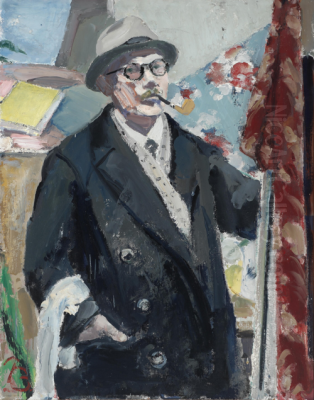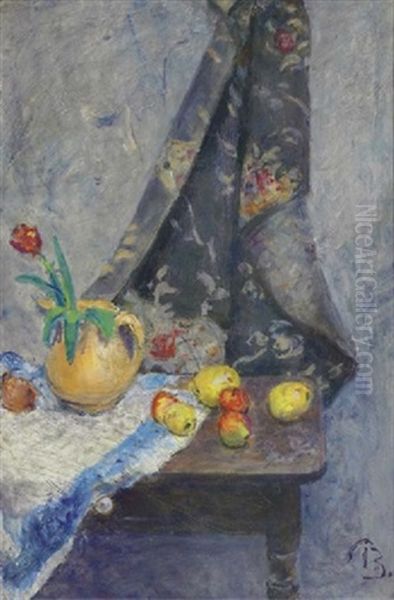
Peter Rostrup Boyesen stands as a significant, albeit sometimes elusive, figure in the narrative of Danish art, particularly noted for his profound impact as an educator in Copenhagen. While the provided historical records sometimes conflate individuals bearing the same name – notably distinguishing the artist from a contemporary mycologist and an engineer – the focus here rests firmly on Peter Rostrup Boyesen, the painter and, more importantly, the influential art teacher whose work shaped a generation of artists. His legacy is primarily cemented through the establishment and running of his art school, a crucible for Danish modernism.
Pinpointing exact biographical dates for the artist Peter Rostrup Boyesen proves challenging based on the available information, which clearly separates him from the mycologist Peter Rostrup Boyesen (born 1831, died 1907). The artist's timeline seems centered around the early to mid-20th century, given his activities and the careers of his students. His primary contribution lies not just in his personal artistic output, but significantly in his role fostering talent and encouraging new directions in Danish art through dedicated pedagogy.
The Rostrup Boyesen School of Art
Central to Peter Rostrup Boyesen's contribution to Danish art was his eponymous art school in Copenhagen, sometimes referred to as a painting academy , which sources suggest was operational or perhaps formally established around 1912. This institution quickly became a vital hub within the city's burgeoning art scene. It served as more than just a place of instruction; it was a dynamic platform where both emerging talents and more established artists could convene, experiment, and exhibit their work.
The school's existence provided a crucial alternative or supplement to more traditional academic training. It attracted artists seeking a different approach, one perhaps more attuned to the rapidly evolving landscape of European modernism. The presence of such an independent school, led by a figure known for encouraging experimentation, undoubtedly played a role in nurturing the diverse expressions that came to characterize Danish art in the following decades. Its influence extended through the artists who passed through its doors, carrying Boyesen's principles and encouragement into their own careers.

Furthermore, the school actively engaged with the public and the art community through exhibitions. Notably, during the 1940s and 1950s, it organized biennial exhibitions at Copenhagen's Danish Theatre, specifically showcasing the work of female artists associated with the school. These events, often curated by the women artists themselves and their colleagues, highlight an important aspect of the school's ethos – providing visibility and support for artists who might have faced greater barriers in the mainstream art world at the time.
Teaching Philosophy and Methods
Peter Rostrup Boyesen's reputation as an educator is consistently described through a compelling paradox: he was known for being both "strict" and "generous." This suggests a teaching environment that demanded discipline and seriousness of purpose, yet was also supportive and nurturing. Perhaps the strictness related to fundamentals of craft or a rigorous work ethic, while the generosity manifested in his willingness to share knowledge, provide opportunities, and foster individual artistic voices.
Crucially, Boyesen is celebrated for encouraging "experimental learning" and "experimental creation." This aspect of his pedagogy aligns perfectly with the spirit of modernism, which challenged academic conventions and prioritized individual expression and formal innovation. By fostering an environment where students felt empowered to experiment, Boyesen was directly contributing to the development of new artistic languages in Denmark. His approach likely involved pushing students beyond comfortable boundaries and encouraging them to explore unconventional materials, techniques, and subject matter.
The impact of this teaching style is attested to by former students. Lennart Rodhe, a significant Swedish artist who studied with Boyesen in Copenhagen, explicitly contrasted the school's atmosphere with the more rigid environment of the academy in Stockholm. Rodhe found Boyesen's school to be characterized by a greater sense of "openness," reinforcing the idea that Boyesen cultivated a space conducive to exploration and personal artistic discovery, despite his underlying strictness. This balance seems key to his success as an influential teacher.
Mentorship and Influence on Artists
Peter Rostrup Boyesen's role extended beyond mere instruction; he was a significant mentor figure for numerous artists who would go on to make their mark on Danish and Scandinavian art. His guidance, rooted in his distinctive teaching philosophy, left a tangible impact on the stylistic development and career trajectories of his students. The school served as an incubator where his influence could directly shape the next wave of artistic talent.

One prominent example is Mogens Valeur, who studied under Boyesen and later became a well-regarded Danish artist. Valeur's early artistic development was reportedly inspired by his time with Boyesen, indicating that the mentorship provided was formative. This relationship underscores Boyesen's ability to identify and nurture potential, guiding students towards finding their own artistic paths while benefiting from his experience and critical eye.
Another artist significantly influenced was Harald Leth. Leth studied with Boyesen during the 1920s, a crucial period for the consolidation of modernism. It is noted that under Boyesen's tutelage, Leth began to employ brighter colors in his work. This specific stylistic shift suggests that Boyesen's encouragement of experimentation might have directly prompted Leth to explore a more vibrant palette, moving away from potentially more subdued, traditional approaches and embracing modernist color sensibilities.
The Swedish artist Lennart Rodhe, as previously mentioned, also benefited greatly from his time at Boyesen's school. His positive assessment of the institution's openness and Boyesen's balanced teaching style highlights the cross-Nordic reach of Boyesen's influence. For Rodhe, the experience in Copenhagen offered a valuable counterpoint to his training elsewhere, broadening his artistic horizons and reinforcing the value of experimental approaches.
Artistic Associations and Context
Peter Rostrup Boyesen did not operate in isolation; he was an active participant in the dynamic Copenhagen art world of his time. His career intersected with those of other key figures, placing him firmly within the currents of Danish Modernism. His associations, whether through direct collaboration, exhibition partnerships, or the shared environment of the city's art scene, help to contextualize his significance.
A notable connection was with Harald Giersing, one of the leading figures of Danish Modernism. Boyesen and Giersing are documented as having submitted works together to the prestigious Charlottenborg exhibition in 1905. Although their initial submissions were reportedly rejected, this joint effort indicates a shared ambition and likely a degree of collegial relationship or alignment in their artistic aims at that early stage. Boyesen's subsequent success in exhibiting at Charlottenborg further solidifies his presence within this important circle. Giersing himself was associated with Boyesen's school, potentially as a visiting artist or influence, further linking the institution to the forefront of Danish art.
Boyesen's influence on Harald Leth also connects him indirectly to another major figure, Olaf Rude, as Leth later studied with Rude. While the provided texts don't confirm direct collaboration between Boyesen and Rude, they were prominent contemporaries navigating the same artistic landscape. Both were associated with the shift towards modernism in Denmark, exploring new approaches to form and color. The Copenhagen art scene at this time was relatively interconnected, and figures like Boyesen, Giersing, and Rude were central to its energy.
The broader context includes numerous other important artists who defined Danish Modernism. Figures such as Vilhelm Lundstrøm, known for his Cubist-inspired still lifes; Edvard Weie, celebrated for his expressive, color-rich compositions; Karl Isakson, another key colorist with ties to the Bornholm school; Sigurd Swane, known for his Fauvist leanings and landscapes; and the versatile Axel Salto, who worked across painting, ceramics, and graphic arts, were all part of the milieu in which Boyesen taught and worked. His school would have been a point of contact or a parallel force within this vibrant ecosystem, contributing to the overall development of modern art in Denmark alongside these influential contemporaries.
Exhibitions and Recognition
Participation in exhibitions was crucial for artists seeking recognition and engagement with the public and critics. Peter Rostrup Boyesen actively sought such opportunities, notably engaging with the established platform of the Charlottenborg exhibitions in Copenhagen. These exhibitions, held at the Royal Danish Academy of Fine Arts, were (and remain) a central institution in the Danish art world, making participation a significant marker of professional engagement.
His attempt to exhibit alongside Harald Giersing in 1905, though initially unsuccessful, demonstrates his early ambition to be recognized within this official venue. More importantly, his successful inclusion in the 1906 Charlottenborg Spring Exhibition marks a key moment of public presentation. The work exhibited, described as themed around Nørrebro's Outer Edge ("Nørrebro's yderkant"), offers a rare glimpse into his own artistic subjects, suggesting an interest in urban landscapes or scenes from Copenhagen life, rendered likely through a modern lens given his associations and teaching focus.
Beyond his personal exhibition activities, Boyesen facilitated exhibition opportunities for others through his art school. The previously mentioned biennial shows for female artists at the Danish Theatre in the 1940s and 50s represent a significant contribution to promoting artists associated with his institution. These events provided valuable exposure and underscored the school's role not just in training, but also in actively supporting the careers of its affiliates, particularly women artists. This commitment to exhibition as part of the educational and professional development process further highlights the comprehensive nature of his contribution.
Beyond Painting: Other Facets
While primarily known as a painter and educator, hints in the source material suggest Peter Rostrup Boyesen possessed broader cultural interests and skills. There is mention of his proficiency in photography, specifically noting his ability in composition and portraiture, demonstrated through outdoor shots taken in Rome. This suggests an eye trained not only for the canvas but also for the photographic lens, capturing "intimate charm" in his subjects against evocative backdrops. Photography, often intertwined with painting during the modernist era, might have informed his visual thinking or even served as a complementary practice.
Additionally, a connection is noted with the prominent Norwegian-American writer Hjalmar Hjorth Boyesen. The text mentions correspondence between them, exploring complex themes related to literature and philosophy. This connection points towards intellectual engagement beyond the visual arts, suggesting Peter Rostrup Boyesen moved within wider cultural circles and participated in the intellectual currents of his time. Such interactions could have enriched his perspective and potentially influenced his teaching or artistic outlook. These facets, though less detailed, add dimension to his profile beyond that of solely a painter and art teacher.
Enduring Legacy
Peter Rostrup Boyesen's primary legacy resides in his profound and lasting impact on Danish art education. Through his Copenhagen art school, he created an environment that nurtured experimentation and individuality, directly contributing to the flourishing of modernism in Denmark. His distinctive teaching style – blending rigor with generosity – proved highly effective, shaping the artistic development of influential figures like Lennart Rodhe, Mogens Valeur, and Harald Leth.
His school served as more than just a place of learning; it was a vital hub in the Copenhagen art scene, fostering connections, providing exhibition opportunities (notably for women artists), and acting as a conduit for new artistic ideas. By encouraging students to break from convention and explore personal expression, Boyesen helped equip a generation of artists with the tools and mindset needed to engage with and advance modern art.
While details of his personal life and a comprehensive catalogue of his own artworks remain somewhat obscured by the available information, his role as a catalyst and mentor is undeniable. He stands as a key figure who, through dedicated teaching and the cultivation of an open yet demanding learning environment, significantly influenced the trajectory of 20th-century Danish art, leaving an indelible mark through the many artists whose careers he helped launch and shape. His contribution is best measured by the success of his students and the vitality of the artistic community he fostered.